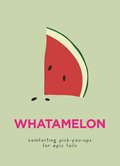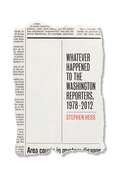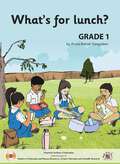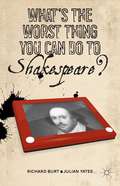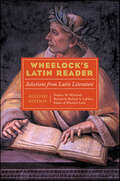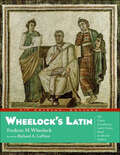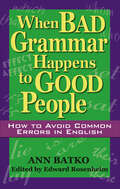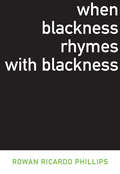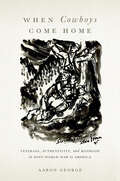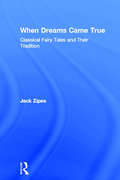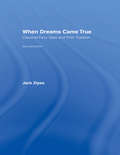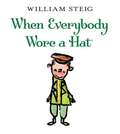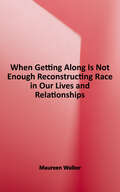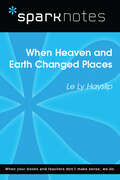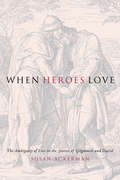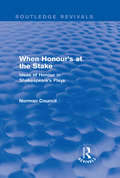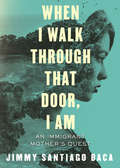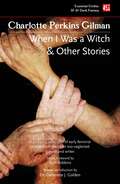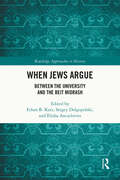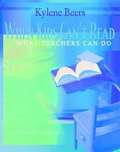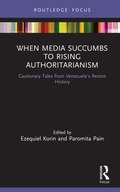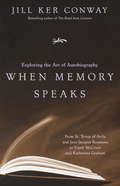- Table View
- List View
WhatAMelon: Comforting pick-you-ups for epic fails
by WhatAMelonIf you know a pearfect numpty who needs a bit of sage advice, chia them up with this little book of upbeat and adorkable fruit puns.#youokalehun?About the seriesThis cute and colourful series of fruit-pun-filled gift books are the perfect pick-me-ups for you, your friend or your partner in crime. Do you need to avocuddle, or are you grapeful for someone who's a bit of a melon? Then share the clove with these little books: AvoCuddle, WhataMelon, You are my Raisin for Living, Don't Give a Fig, I am Grapeful, You are 24 Carrot Gold.*veg, nuts and seeds are fair game
Whatever Happened to the Washington Reporters, 1978-2012
by Stephen HessWhatever Happened to the Washington Reporters, 1978-2012, is the first book to comprehensively examine career patterns in American journalism. In 1978 Brookings Senior Fellow Stephen Hess surveyed 450 journalists who were covering national government for U.S. commercial news organizations. His study became the award-winning The Washington Reporters (Brookings, 1981), the first volume in his Newswork series. Now, a generation later, Hess and his team from Brookings and the George Washington University have tracked down 90 percent of the original group, interviewing 283, some as far afield as France, England, Italy, and Australia.What happened to the reporters within their organizations? Did they change jobs? Move from reporter to editor or producer? Jump from one type of medium to another--from print to TV? Did they remain in Washington or go somewhere else? Which ones left journalism? Why? Where did they go?A few of them have become quite famous, including television correspondents Ted Koppel, Sam Donaldson, Brit Hume, Carole Simpson, Judy Woodruff, and Marvin Kalb; some have become editors or publishers of the New York Times, Wall Street Journal, Chicago Tribune, Miami Herald, or Baltimore Sun; some have had substantial careers outside of journalism. Most, however, did not become household names.The book is designed as a series of self-contained essays, each concentrating on one characteristic, such as age, gender, or place of employment, including newspapers, television networks, wire services, and niche publications. The reporters speak for themselves. When all of these lively portraits are analyzed--one by one--the results are surprisingly different from what journalists and sociologists in 1978 had predicted.
Whatever Happened to the Washington Reporters, 1978-2012
by Stephen HessWhatever Happened to the Washington Reporters, 1978-2012, is the first book to comprehensively examine career patterns in American journalism. In 1978 Brookings Senior Fellow Stephen Hess surveyed 450 journalists who were covering national government for U.S. commercial news organizations. His study became the award-winning The Washington Reporters (Brookings, 1981), the first volume in his Newswork series. Now, a generation later, Hess and his team from Brookings and the George Washington University have tracked down 90 percent of the original group, interviewing 283, some as far afield as France, England, Italy, and Australia. What happened to the reporters within their organizations? Did they change jobs? Move from reporter to editor or producer? Jump from one type of medium to another-from print to TV? Did they remain in Washington or go somewhere else? Which ones left journalism? Why? Where did they go? A few of them have become quite famous, including television correspondents Ted Koppel, Sam Donaldson, Brit Hume, Carole Simpson, Judy Woodruff, and Marvin Kalb; some have become editors or publishers of the New York Times, Wall Street Journal, Chicago Tribune, Miami Herald, or Baltimore Sun; some have had substantial careers outside of journalism. Most, however, did not become household names. The book is designed as a series of self-contained essays, each concentrating on one characteristic, such as age, gender, or place of employment, including newspapers, television networks, wire services, and niche publications. The reporters speak for themselves. When all of these lively portraits are analyzed-one by one-the results are surprisingly different from what journalists and sociologists in 1978 had predicted.
What’s for lunch? class 1 - MIE
by Aruna Ankiah Gangadeen"What's for Lunch?" invites Grade 1 readers into a delightful lunchtime scene with Ben and his friends. As the bell rings, signaling lunch, the children eagerly gather under a tree, unpacking their lunch bags filled with delectable treats. Excitement fills the air as they share their delicious meals – from Ben's favorite sausage and lettuce sandwich to Sara's crispy chips with ketchup, Rishi's flavorful fried rice with vegetables and chicken, and Anna's tempting chocolate cake, generously offered to her friends. Through engaging illustrations and simple language, the book captures the joy of mealtime and sharing, fostering discussions among young readers about their own lunch preferences and the importance of sharing and expressing gratitude.
What’s the Worst Thing You Can Do to Shakespeare?
by Richard BurtWhat's the worst thing you can do to Shakespeare? The answer is simple: don't read him. To that end, Richard Burt and Julian Yates embark on a project of un/reading the Bard, turning the conventional challenges into a roadmap for textual analysis and a thorough reconsideration of the plays in light of their absorption into global culture.
Wheelock's Latin Reader: Selections from Latin Literature
by Frederick M. WheelockOriginally intended by Professor Frederic M. Wheelock as a sequel to Wheelock's Latin, his classic introductory Latin textbook, Wheelock's Latin Reader, newly revised and updated by Richard A. LaFleur, is the ideal text for any intermediate-level Latin course. You'll find a rich selection of of prose and poetry from a wide range of classical authors, as well as briefer passages from medieval and Late Latin writers, each presented in the Latin in which it was originally written. Useful features include extensive notes; a complete Latin-English vocabulary; maps of ancient Italy, Greece, and the Roman Empire; and numerous photographs illustrating aspects of classical culture, mythology, and history featured in the readings.
Wheelock's Latin: The Classic Introductory Latin Course, Based on Ancient Authors
by Frederic M. WheelockThe classic introductory Latin textbook, first published in 1956, and still the bestselling and most highly regarded textbook of its kind.Revised and expanded, this sixth edition of classics professor Frederic M. Wheelock's Latin has all the features that have made it the bestselling single-volume beginning Latin textbook and more:* Forty chapters with grammatical explanations and readings based on ancient Roman authors* Self-tutorial exercises with an answer key for independent study* An extensive English-Latin/Latin-English vocabulary section* A rich selection of original Latin readings—unlike other textbooks which contain primarily made-up Latin texts* Etymological aidsAlso includes maps of the Mediterranean, Italy and the Aegean area, as well as numerous photographs illustrating aspects of classical culture, mythology, and historical and literary figures presented in the chapter readings.
When Bad Grammar Happens to Good People: How to Avoid Common Errors in English
by Ann BatkoDiscover an easy way to polish up your English with this guide to avoiding common mistakes people make when writing and speaking.Good news—you’re definitely not the only person who struggles to keep “who” and “whom,” “affect” and “effect,” or “lay” and “lie” straight. Bad news: Frequent grammatical errors can affect (not effect) your success at work and in other areas of life.This comprehensive, easy-to-use reference is a program designed to help you identify and correct the most common errors in written and spoken English. After a short, simple review of some basic principles, When Bad Grammar Happens to Good People is organized by error type, such as Mangled Modifiers or Mixing up Words that Sound the Same. You choose how to work your way through, either sequentially or in the order most relevant to you. Each unit contains tests at the end to help you reinforce what you’ve learned. Best of all, the information is presented in a clear, lively, and conversational style—unlike your eighth-grade grammar textbook!
When Blackness Rhymes with Blackness
by Rowan Ricardo PhillipsIn When Blackness Rhymes with Blackness, Rowan Ricardo Phillips pushes African American poetry to its limits by unraveling "our desire to think of African American poetry as African American poetry." Phillips reads African American poetry as inherently allegorical and thus "a successful shorthand for the survival of a poetry but unsuccessful shorthand for the sustenance of its poems." Arguing in favor of the "counterintuitive imagination," Phillips demonstrates how these poems tend to refuse their logical insertion into a larger vision and instead dwell indefinitely at the crux between poetry and race, "where, when blackness rhymes with blackness, it is left for us to determine whether this juxtaposition contains a vital difference or is just mere repetition." From When Blackness Rhymes with Blackness: Phillis Wheatley, like the epigraphs that writers fit into the beginning of their texts, is first and foremost a cultural sign, a performance. It is either in the midst of that performance ("at a concert"), or in that performance's retrospection ("in a cafe´"), that a retrievable form emerges from the work of a poet whose biography casts a far longer shadow than her poems ever have. Next to Langston Hughes, of all African American poets Wheatley's visual image carries the most weight, recognizable to a larger audience by her famed frontispiece, her statue in Boston, and the drama behind the publication of her book, Poems on Various Subjects Religious and Moral. All of this will be fruit for discussion in the pages that follow. Yet, I will also be discussing the proleptic nature with which African American literature talks, if you will, Phillis Wheatley.
When Blackness Rhymes with Blackness
by Rowan Ricardo PhillipsIn When Blackness Rhymes with Blackness, Rowan Ricardo Phillips pushes African American poetry to its limits by unraveling "our desire to think of African American poetry as African American poetry." Phillips reads African American poetry as inherently allegorical and thus "a successful shorthand for the survival of a poetry but unsuccessful shorthand for the sustenance of its poems." Arguing in favor of the "counterintuitive imagination," Phillips demonstrates how these poems tend to refuse their logical insertion into a larger vision and instead dwell indefinitely at the crux between poetry and race, "where, when blackness rhymes with blackness, it is left for us to determine whether this juxtaposition contains a vital difference or is just mere repetition." From When Blackness Rhymes with Blackness: Phillis Wheatley, like the epigraphs that writers fit into the beginning of their texts, is first and foremost a cultural sign, a performance. It is either in the midst of that performance ("at a concert"), or in that performance's retrospection ("in a cafe´"), that a retrievable form emerges from the work of a poet whose biography casts a far longer shadow than her poems ever have. Next to Langston Hughes, of all African American poets Wheatley's visual image carries the most weight, recognizable to a larger audience by her famed frontispiece, her statue in Boston, and the drama behind the publication of her book, Poems on Various Subjects Religious and Moral. All of this will be fruit for discussion in the pages that follow. Yet, I will also be discussing the proleptic nature with which African American literature talks, if you will, Phillis Wheatley.
When Cowboys Come Home: Veterans, Authenticity, and Manhood in Post–World War II America
by Aaron GeorgeWhen Cowboys Come Home: Veterans, Authenticity, and Manhood in Post–World War II America is a cultural and intellectual history of the 1950s that argues that World War II led to a breakdown of traditional markers of manhood and opened space for veterans to reimagine what masculinity could mean. One particularly important strand of thought, which influenced later anxieties over “other-direction” and “conformity,” argued that masculinity was not defined by traits like bravery, stoicism, and competitiveness but instead by authenticity, shared camaraderie, and emotional honesty. To elucidate this challenge to traditional “frontiersman” masculinity, Aaron George presents three intellectual biographies of important veterans who became writers after the war: James Jones, the writer of the monumentally important war novel From Here to Eternity; Stewart Stern, one of the most important screenwriters of the fifties and sixties, including for Rebel without a Cause; and Edward Field, a bohemian poet who used poetry to explore his love for other men. Through their lives, George shows how wartime disabused men of the notion that war was inherently a brave or heroic enterprise and how the alienation they felt upon their return led them to value the authentic connections they made with other men during the war.
When Dreams Came True: Classical Fairy Tales and Their Tradition
by Jack ZipesFirst Published in 1999. Routledge is an imprint of Taylor & Francis, an informa company.
When Dreams Came True: Classical Fairy Tales and Their Tradition
by Jack ZipesFor centuries fairy tales have been a powerful mode of passing cultural values onto our children, and for many these stories delight and haunt us from cradle to grave. But how have these stories become so powerful and why? In When Dreams Came True, Jack Zipes explains the social life of the fairy tale, from the sixteenth century on into the twenty-first. Whether exploring Charles Perrault or the Brothers Grimm, Hans Christian Andersen or The Thousand and One Nights, The Happy Prince or Pinocchio, L. Frank Baum or Hermann Hesse, Zipes shows how the authors of our beloved fairy tales used the genre to articulate personal desires, political views, and aesthetic preferences within particular social contexts. Above all, he demonstrates the role that the fairy tale has assumed in the civilizing process—the way it imparts values, norms, and aesthetic taste to children and adults. This second edition of one of Jack Zipes’s best-loved books includes a new preface and two new chapters on J.M. Barrie’s Peter Pan and E.T.A. Hoffman’s The Nutcracker and the Mouse King.
When Everybody Wore a Hat
by William SteigFrom the book: This is the story of when I was a boy, almost 100 years ago, when fire engines were pulled by horses, boys did not play with girls, kids went to libraries for books, there was no TV, you could see a movie for a nickel, and everybody wore a hat.
When Getting Along is not Enough: Reconstructing Race in Our Lives and Relationships
by Maureen Walker“Using anecdotes from her psychology practice, Walker provides a way for educators and social service professionals to enter into cross-racial discussions about race and racial relations. She identifies skills that are essential for repairing the damage wrought by racism and provides exercises to stimulate group conversations in staff development, classrooms, and workplace training”-- Provided by publisher.
When Heaven and Earth Changed Places (SparkNotes Literature Guide Series)
by SparkNotesWhen Heaven and Earth Changed Places (SparkNotes Literature Guide) by Le Ly Hayslip Making the reading experience fun! Created by Harvard students for students everywhere, SparkNotes is a new breed of study guide: smarter, better, faster. Geared to what today's students need to know, SparkNotes provides: *Chapter-by-chapter analysis *Explanations of key themes, motifs, and symbols *A review quiz and essay topicsLively and accessible, these guides are perfect for late-night studying and writing papers
When Heroes Love: The Ambiguity of Eros in the Stories of Gilgamesh and David (Gender, Theory, and Religion)
by Susan AckermanToward the end of the Mesopotamian Epic of Gilgamesh King Gilgamesh laments the untimely death of his comrade Enkidu, "my friend whom I loved dearly." Similarly in the Bible, David mourns his companion, Jonathan, whose "love to me was wonderful, greater than the love of women." These passages, along with other ambiguous erotic and sexual language found in the Gilgamesh epic and the biblical David story, have become the object of numerous and competing scholarly inquiries into the sexual nature of the heroes' relationships. Susan Ackerman's innovative work carefully examines the stories' sexual and homoerotic language and suggests that its ambiguity provides new ways of understanding ideas of gender and sexuality in the ancient Near East and its literature. In exploring the stories of Gilgamesh and Enkidu and David and Jonathan, Ackerman cautions against applying modern conceptions of homosexuality to these relationships. Drawing on historical and literary criticism, Ackerman's close readings analyze the stories of David and Gilgamesh in light of contemporary definitions of sexual relationships and gender roles. She argues that these male relationships cannot be taken as same-sex partnerships in the modern sense, but reflect the ancient understanding of gender roles, whether in same- or opposite-sex relationships, as defined as either active (male) or passive (female). Her interpretation also considers the heroes' erotic and sexual interactions with members of the opposite sex.Ackerman shows that the texts' language and erotic imagery suggest more than just an intense male bonding. She argues that, though ambiguous, the erotic imagery and language have a critical function in the texts and serve the political, religious, and aesthetic aims of the narrators. More precisely, the erotic language in the story of David seeks to feminize Jonathan and thus invalidate his claim to Israel's throne in favor of David. In the case of Gilgamesh and Enkidu, whose egalitarian relationship is paradoxically described using the hierarchically dependent language of sexual relationships, the ambiguous erotic language reinforces their status as liminal figures and heroes in the epic tradition.
When Heroes Sing
by Sarah NooterThis book examines the lyrical voice of Sophocles' heroes and argues that their identities are grounded in poetic identity and power. It begins by looking at how voice can be distinguished in Greek tragedy and by exploring ways that the language of tragedy was influenced by other kinds of poetry in late fifth-century Athens. In subsequent chapters, Professor Nooter undertakes close readings of Sophocles' plays to show how the voice of each hero is inflected by song and other markers of lyric poetry. She then argues that the heroes' lyrical voices set them apart from their communities and lend them the authority and abilities of poets. Close analysis of the Greek texts is supplemented by translations and discussions of poetic features more generally, such as apostrophe and address. This study offers new insight into the ways that Sophoclean tragedy inherits and refracts the traditions of other poetic genres.
When Honour's at the Stake (Routledge Revivals)
by Norman CouncilRenaissance ideas of honour had a profound influence on the English people who formed Shakespeare’s audiences. In When Honour’s at the Stake, first published in 1973, Norman Council describes the increasing importance of these ideas to the themes and structure of a number of Shakespeare’s major plays. The validity of the most widely approved code of honour was being challenged on a variety of fronts, yet both personal standards of behaviour and public affairs were habitually understood in terms of honour. A series of tragedies are given their basic form by dramatizing the pernicious effects of man’s disobedience to the various demands of honour; in Julius Caesar, Troilus and Cressida, Hamlet, Othello, and King Lear honour is among the principal motives of tragedy. In this way, the modern reader’s comprehension of the plays can be greatly enhanced by reference to Elizabethan honour codes.
When I Walk Through That Door, I Am: An Immigrant Mother's Quest
by Jimmy Santiago BacaPoet-activist Jimmy Baca immerses the reader in an epic narrative poem, imagining the experience of motherhood in the context of immigration, family separation, and ICE raids on the Southern border.Jimmy Santiago Baca sends us on a journey with Sophia, an El Salvadorian mother facing a mountain of obstacles, carrying with her the burden of all that has come before: her husband's murder, a wrenching separation from her young son at the border, then rape and abuse at the hands of ICE, yet persevering: "I keep walking/carrying you in my thoughts," she repeats, as she wills her boy to know she is on a quest to find him.
When I Was a Witch & Other Stories (Foundations of Feminist Fiction)
by Charlotte Perkins GilmanA powerful collection of early feminist stories from the activist and writer Charlotte Perkins Gilman.Gilman created a world that could be viewed from the feminist gaze. She focused on how women were not just stay-at-home mothers they were expected to be but also people who had dreams, who were able to travel and work just as men did, and whose goals included a society where women were just as important as men. In the early 1900s this was striking and revolutionary. The stories in this collection are: 'A Coincidence'; 'According To Solomon', 'An Offender', 'A Middle-Sized Artist', 'Martha's Mother', 'Her Housekeeper', 'When I Was A Witch', 'Making a Living', 'A Coincidence, The Cottagette', 'The Boys and the Butter', 'My Astonishing Dodo', and 'A Word In Season'. Foundations of Feminist Fiction. The early 1900s saw a quiet revolution in literature dominated by male adventure heroes. Both men and women moved beyond the norms of the male gaze to write from a different gender perpective, sometimes with female protagonists, but also expressing the universal freedom to write on any subject whatsoever.
When Jews Argue: Between the University and the Beit Midrash (Routledge Approaches to History)
by Ethan B. Katz Sergey Dolgopolski Elisha AncselovitsThis book re-thinks the relationship between the world of the traditional Jewish study hall (the Beit Midrash) and the academy: Can these two institutions overcome their vast differences? Should they attempt to do so? If not, what could two methods of study seen as diametrically opposed possibly learn from one another? How might they help each other reconceive their interrelationship, themselves, and the broader study of Jews and Judaism? This book begins with three distinct approaches to these challenges. The chapters then follow the approaches through an interdisciplinary series of pioneering case studies that reassess a range of topics including religion and pluralism in Jewish education; pain, sexual consent, and ethics in the Talmud; the place of reason and devotion among Jewish thinkers as diverse as Moses Mendelssohn, Jacob Taubes, Sarah Schenirer, Ibn Chiquitilla, Yair Ḥayim Bacharach, and the Rav Shagar; and Jewish law as a response to the post-Holocaust landscape. The authors are scholars of rabbinics, history, linguistics, philosophy, law, and education, many of whom also have traditional religious training or ordination. The result is a book designed for learned scholars, non-specialists, and students of varying backgrounds, and one that is sure to spark debate in the university, the Beit Midrash, and far beyond.
When Kids Can't Read, What Teachers Can Do: A Guide for Teachers 6-12
by Kylene Beers"If I had to recommend just one book to middle and secondary teachers working to support struggling readers, this would have to be the book. When Kids Can't Read, What Teachers Can Do is a comprehensive handbook filled with practical strategies that teachers of all subjects can use to make reading skills transparent and accessible to adolescents. Bending theory with practice throughout, Kylene Beers moves teachers from assessment to instruction - from describing dependent reading behaviours to suggesting ways to help students with vocabulary, fluency, comprehension, work recognition, response to text, and so much more. But it's not just the strategies that make this book so valuable. It's the invitations to "step inside a classroom" and eavesdrop on teacher/student interactions. It's the student profiles, the "if/then" charts, the extensive booklists and, of course, the experiences of a brilliant reading teacher. This is simply the best book published to date to support struggling adolescent readers!" Gillda Leitenberg, District-wide Coordinator, English/Literacy Toronto District School Board
When Media Succumbs to Rising Authoritarianism: Cautionary Tales from Venezuela’s Recent History (Routledge Focus on Journalism Studies)
by Ezequiel Korin and Paromita PainThis book provides a transversal scholarly exploration of the multiple changes exhibited around Venezuelan media during the Chávez regime. Bringing together a body of original research by key scholars in the field, the book looks at the different processes entailed by Chavismo’s relationship with the media, extending their discussion beyond the boundaries of the specific cases or examples and into the entire articulation of a nearly-perfect communicational hegemony. It explores the wide-ranging transformations in the national mediascape, such as how censorship of journalistic endeavors has impacted news consumption/production in the country to the complexities of Venezuelan filmmaking during Chavismo, from the symbolic postmortem persistence of Chávez to the profound transformations undergone by telenovelas, from the politically induced migration of online audiences to the reinvention of media spaces for cultural journalism as forms of resistance. Allowing readers to engage not only with the particular case studies or exemplars presented, but with the underlying cultural, economic, political, societal, and technical aspects that come into play and which allow the extrapolation of this body of research onto other national or international contexts, this book will be an important resource for scholars and students of journalism, communication, media studies, and politics.
When Memory Speaks: Exploring the Art of Autobiography
by Jill Ker ConwayJ ill Ker Conway, one of our most admired autobiographers--author of The Road from Coorain and True North--looks astutely and with feeling into the modern memoir: the forms and styles it assumes, and the strikingly different ways in which men and women respectively tend to understand and present their lives.In a narrative rich with evocations of memoirists over the centuries--from Jean-Jacques Rousseau and George Sand to W. E. B. Du Bois, Virginia Woolf, Frank McCourt and Katharine Graham--the author suggests why it is that we are so drawn to the reading of autobiography, and she illuminates the cultural assumptions behind the ways in which we talk about ourselves. Conway traces the narrative patterns typically found in autobiographies by men to the tale of the classical Greek hero and his epic journey of adventure. She shows how this configuration evolved, in memoirs, into the passionate romantic struggling against the conventions of society, into the frontier hero battling the wilderness, into self-made men overcoming economic obstacles to create an invention or a fortune--or, more recently, into a quest for meaning, for an understandable past, for an ethnic identity.In contrast, she sees the designs that women commonly employ for their memoirs as evolving from the writings of the mystics--such as Dame Julian of Norwich or St. Teresa of Avila--about their relationship with an all-powerful God. As against the male autobiographer's expectation of power over his fate, we see the woman memoirist again and again believing that she lacks command of her destiny, and tending to censor her own story.Throughout, Conway underlines the memoir's magic quality of allowing us to enter another human being's life and mind--and how this experience enlarges and instructs our own lives.
